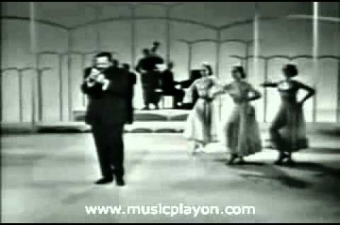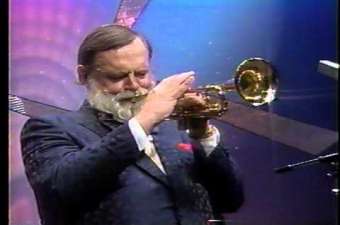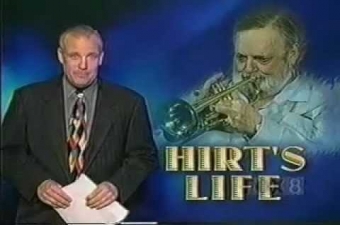Al Hirt’s Club
501 BourbonNew Orleans LA 70130
Al Hirt was flying high in 1964. He had two albums climbing the charts and a hit single, “Java,” (an instrumental composed by Allen Toussaint) being hummed across the country. He also took over Dan’s Pier 600, the club at 501 Bourbon Street where he’d been a featured performer. He updated the place, installing a revolving stage in the middle of the room, and reopened it as Al Hirt’s Club, the city’s “smartest nightclub.” He resumed his regular performances and, when he went on tour, big names in jazz like Cannonball Adderley, Dizzy Gillespie, and Lionel Hampton headlined.
Hirt, nicknamed “Jumbo” for his musical prowess as well as hefty frame, was a prodigiously talented trumpeter. After working with Benny Goodman, Tommy Dorsey and other big bands in the 1940s, he returned home to New Orleans and played alongside traditional jazz revivalists like his friend Pete Fountain. Still, Hirt, who was conservatory-trained, considered himself “a pop commercial musician” as opposed to a jazz artist.
He had a point. He charted with dozens of albums in a variety of musical bags. In addition to “Java,” which went gold and earned him a Grammy, he hit the singles chart with “Cotton Candy” and played the theme song for “The Green Hornet.” He played Las Vegas and appeared on Dinah Shore’s TV show.
Hirt attained a remarkable level of cultural currency for an instrumentalist, performing at President John F. Kennedy’s inauguration and for Pope John Paul II’s visit to New Orleans in 1987 (the latter of which Hirt considered the most important engagement of his career). He also owned a piece of the New Orleans Saints football team when it formed, and secured his place in trivia contests for all time by playing the halftime show for the first Super Bowl in 1967.
Hirt closed the club in disgust in 1983, complaining that the strip had gotten too “rowdy.” He didn’t stay away for long, though. Associates of his reopened the club at 501 Bourbon as Jelly Roll’s, and he performed there until his death in 1999. His statue now overlooks the strip from Legends Park at 311 Bourbon Street.
About Bourbon Street
Bourbon Street, one of the most famous streets in the country, is only 14 blocks long, running through the middle of the French Quarter. It took off as an entertainment district in the 1940s, when wartime activity brought waves of visitors to New Orleans. Bands often performed in floor shows featuring burlesque dancers (who stripped to varying degrees), comedians, and other entertainers.
This freewheeling era came to a close, in the eyes of many patrons, with District Attorney Jim Garrison’s vice raids in the early 1960s. Crime — organized and not — was pervasive on Bourbon Street, and Garrison’s crusade scored some political points. The resulting loss of revenue at the clubs, meanwhile, scaled back entertainment budgets.
The only black people on Bourbon Street at the time were there to work (musicians were generally considered hired help; some had to wait in storerooms between sets). Even after the passage of civil rights legislation some clubs resisted integration, and audiences on Bourbon Street remained largely white for years afterward.
In recent decades, as the city relied increasingly on tourism to prop up its economy, the market dictated more changes: Modern stripping supplanted burlesque and DJ booths replaced bandstands. The street became a pedestrian mall, filled with go-cups and Mardi Gras beads year-round. Several clubs sticking with live music offered low wages for bands to play songs familiar to visitors.
Hand-wringing about the quality and nature of live music on the strip has been more or less constant since the 1950s, and not without reason. Still, some venues persisted in hiring reputable artists. In the 2000s, the To Be Continued Brass Band took matters into their own hands, breaking into the scene by playing on the corner of Bourbon and Canal Street every night.
In any case millions of visitors to the strip each year find the spectacle they’re looking for, exotic but approachable, with a more permissive atmosphere than they feel at home. Its economic impact on the city is in the billions. If it’s crass it’s also egalitarian: Bourbon Street today is among the more integrated spaces in town.
Videos

Al Hirt performing "Java," the Allen Toussaint tune, on The Ed Sullivan Show in 1963. His recording of the song won a Grammy the following year.
Video from musicplayon.com.
Al Hirt performing "Java," the Allen Toussaint tune, on The Ed Sullivan Show in 1963. His recording of the song won a Grammy the following year.

Al Hirt on The Johnny Cash Show.
Al Hirt on The Johnny Cash Show.

The Al Hirt Band playing a medley of hits in the spring of 1987 at the West Virginia Jazz Festival in Charleston, WV.
Video from WPBY-TV, West Virginia Public Broadcasting.
The Al Hirt Band playing a medley of hits in the spring of 1987 at the West Virginia Jazz Festival in Charleston, WV.

News coverage of the passing of Al Hirt in 1999, including remembrances by Chris Owens, Pete Fountain, and Allen Toussaint.
Video from Fox 8 in New Orleans.
News coverage of the passing of Al Hirt in 1999, including remembrances by Chris Owens, Pete Fountain, and Allen Toussaint.
Images


















